Mechanical Properties of Cast-in Anchor Bolts Manufactured of Reinforcing Tempcore Steel
Abstract
:1. Introduction
2. Material Properties
3. Experimental Program
3.1. Experimental Procedure
- Unmodified rebar
- Rebar with 1/6φ removed by peeling
- Rebar with 1/3φ removed by peeling
- Rebar with 2/3φ removed by peeling
3.2. Tensile Test
3.3. Hardness Test
4. Experimental Results and Discussion
4.1. Microstructures of Tested Rebars
4.2. Assessment of Tensile Tests
4.3. Assessment of Hardness Test
5. Conclusions
- (1)
- The tensile strength of all tested rebars modified by peeling is higher than 550 MPa. It is thus appropriate to calculate the characteristic value of resistance of the thread using the characteristic value of tensile strength of the base material B500B (fuk = 550 MPa).
- (2)
- The yield strength of tested rebars with diameter 25 mm modified by peeling is slightly lower than 500 MPa. The reduction of strength after peeling is probably related to the microstructure of the rebar. Such reduction does not penalize the structural performance of the anchor bolt, as the tensile capacity of the thread is derived from the tensile strength and not the yield strength of the material of the thread.
- (3)
- The experiment shows that the Vickers hardness test is an appropriate method for the prediction of mechanical properties of reinforcement bars, but with less accuracy than the tensile tests. According to experiment, it is possible to derive an empirical relationship between HV and TS with an accuracy of ±12%.
- (4)
- In practice, Tempcore rebars are suitable for the manufacturing of cast-in anchor bolts. Of course, the mechanical properties of such anchor bolts have to be confirmed by a continuous quality control performed by the manufacturers.
Author Contributions
Funding
Conflicts of Interest
References
- EN 1992-1-1. Eurocode 2. Design of Concrete Structures—Part 1-1: General Rules and Rules for Building; CEN: Brussels, Belgium, 2015. [Google Scholar]
- EN 1993-1-8. Eurocode 3. Design of Steel Structures. Part 1-8: Design of Joints; CEN: Brussels, Belgium, 2007. [Google Scholar]
- Fib Bulletin no. 58. In Design of Anchorages in Concrete; fib CEB-FIB: Lausanne, Switzerland, 2011.
- HPM Rebar Anchor Bolts. Technical Manual; Peikko group: Lahti, Finland, 2015. [Google Scholar]
- Bujňák, J.; Farbák, M. Tests of Short Headed Bars with Anchor Reinforcement Used in Beam-to-Column Joints. Aci. Struct. J. 2018, 15, 203–210. [Google Scholar] [CrossRef]
- EAD 330924-00-0601. Cast-in Anchor Bolt of Ribbed Reinforcing Steel; EOTA: Brussels, Belgium, 2018. [Google Scholar]
- Simon, P.; Economopoulos, M.; Nilles, P. Tempcore a new process for the production of high-quality reinforcing bars. Iron. Steel Eng. 1984, 61, 53–57. [Google Scholar]
- Rehm, G.; Russwurm, D. Assessment of concrete reinforcing bars made by the Tempcore process of Concrete. CRM Revue. 1977, 51, 1–16. [Google Scholar]
- Nino, O.; Martinez, D.; Lizcano, C.; Guerrero-Mata, M.; Colás, R. Study of the Tempcore process for the Production of High Resistance Reinforcing Rods. Mater. Sci. Forum 2007, 537–538, 533–540. [Google Scholar] [CrossRef]
- Cadoni, E.; Dotta, M.; Forini, D.; Tesio, N.; Albertini, C. Mechanical behaviour of quenched and self-tempered reinforcing steel in tension under high strain rate. Mater. Des. 2013, 49, 657–666. [Google Scholar] [CrossRef]
- Nikolaou, J.; Papadimitriou, G.D. Microstructures and mechanical properties after heating of reinforcing 500 MPa class weldable steels produced by various processes. Construc. Build. Mater. 2004, 18, 243–254. [Google Scholar] [CrossRef]
- Noville, J.F. TEMPCORE, the most convenient process to produce low cost high strength rebars form 8 to 75 mm. In Proceedings of the METEC and 2nd ESTAT, Dusseldorf, Germany, 15–19 June 2015. [Google Scholar]
- Foraboschi, P. Versatility of steel in correcting construction deficiencies and in seismic retrofitting of RC buildings. J Build. Eng. 2016, 8, 107–122. [Google Scholar] [CrossRef]
- Foraboschi, P. Structural layout that takes full advantage of the capabilities and opportunities afforded by two-way RC floors, coupled with the selection of the best technique, to avoid serviceability failures. Eng. Fail. Anal. 2016, 70, 387–418. [Google Scholar] [CrossRef]
- Madias, J.; Wright, M.; Behr, G.O.; Valladares, V. Analysis of International Standards on Concrete-reinforcing Steel Bar. AIStech Proc. 2017, 2505–2515. [Google Scholar] [CrossRef]
- Beeby, A.W. Ductility in reinforced concrete: Why is it needed and how is it achieved? Struct. Eng. 1997, 75, 311–318. [Google Scholar]
- Ede, N.A.; Olofinnade, M.O.; Joshua, O. Experimental Investigation of Yield Strength of Steel Reinforcing Bar Used in Nigerian Concrete Structures. Int. J. Sci. Eng. Res. 2014, 5, 76–83. [Google Scholar]
- Economopoulos, M.; Respen, Y.; Lessel, G.; Steffes, G. Application of the tempcore Process to the fabrication of High Yield Strength Concrete—Reinforcing Bars. CRM 1975, 45, 3–19. [Google Scholar]
- Malvar, L.J. Review of static and dynamic properties of steel reinforcing bars. Aci. Mater. J. 1998, 95, 609–616. [Google Scholar]
- Zheng, H.; Abel, A.A. Fatigue properties of reinforcing steel produced by Tempcore process. J. Mater. Civ. Eng. 1999, 11, 158–165. [Google Scholar] [CrossRef]
- Lin, F.; Dong, Y.; Kuang, X.; Lu, L. Strain Rate Behavior in Tension of reinforcing Steels HPB235, HDB335, HRB400, and HRB500. Materials 2016, 9, 1013. [Google Scholar] [CrossRef] [PubMed]
- Mainstone, R.J. Properties of materials at high rates of straining or loading. Mater. Constr. 1975, 8, 102–116. [Google Scholar] [CrossRef]
- Santos, J.; Henriques, A.A. Strength and Ductility of Damaged Tempcore Rebars. Proc. Eng. 2015, 114, 800–807. [Google Scholar] [CrossRef] [Green Version]
- EN ISO 6892-1. Metallic Materials—Tensile testing—Part 1: Method of Test at Room Temperature; CEN: Brussels, Belgium, 2016. [Google Scholar]
- EN ISO 15630-1. Steel for the Reinforcement and Prestressing of Concrete. Test Methods. Part 1: Reinforcing Bars, Wire Rod and Wire; CEN: Brussels, Belgium, 2012. [Google Scholar]
- EN ISO 6507-1. Metallic Materials—Vickers Hardness Test. Part 1: Test Method; IOS: Geneva, Switzerland, 2005. [Google Scholar]
- ASM Handbook Committee. Metals Handbook, 9th ed.; Mechanical Testing; American Society for Metals: Russell Township, OH, USA, 1985; Volume 8. [Google Scholar]
- EN ISO 18265. Metallic Materials—Conversion of Hardness Values; ISO: Geneva, Switzerland, 2014. [Google Scholar]
- Arbtin, E., Jr.; Murphy, G. Correlation of Vickers Hardness Number, Modulus of Elasticity, and the Yield Strength for Ductile Metals; Ames Laboratory ISC Technical Reports 50: Ames, IA, USA, 1953. [Google Scholar]
- Gaško, M.; Rosenberg, G. Correlation between hardness and tensile properties in ultra-high strength dual phase steels-short communication. Mater. Eng. 2011, 18, 155–159. [Google Scholar]
- Tekkaya, E.A. Improved relationship between Vickers hardness and yield stress for cold formed materials. Steel Res. 2001, 72, 283–321. [Google Scholar] [CrossRef]
- Zhang, P.; Li, Y.F.; Yhang, Y.F. General relationship between strength and hardness. Mater. Sci. Eng. A 2011, 529, 62–73. [Google Scholar] [CrossRef]
- Pavlina, E.J.; Van Type, C.J. Correlation of Yield Strength and Tensile Strength with Hardness for Steels. Mater. Eng. Perform 2008, 17, 888–893. [Google Scholar] [CrossRef]

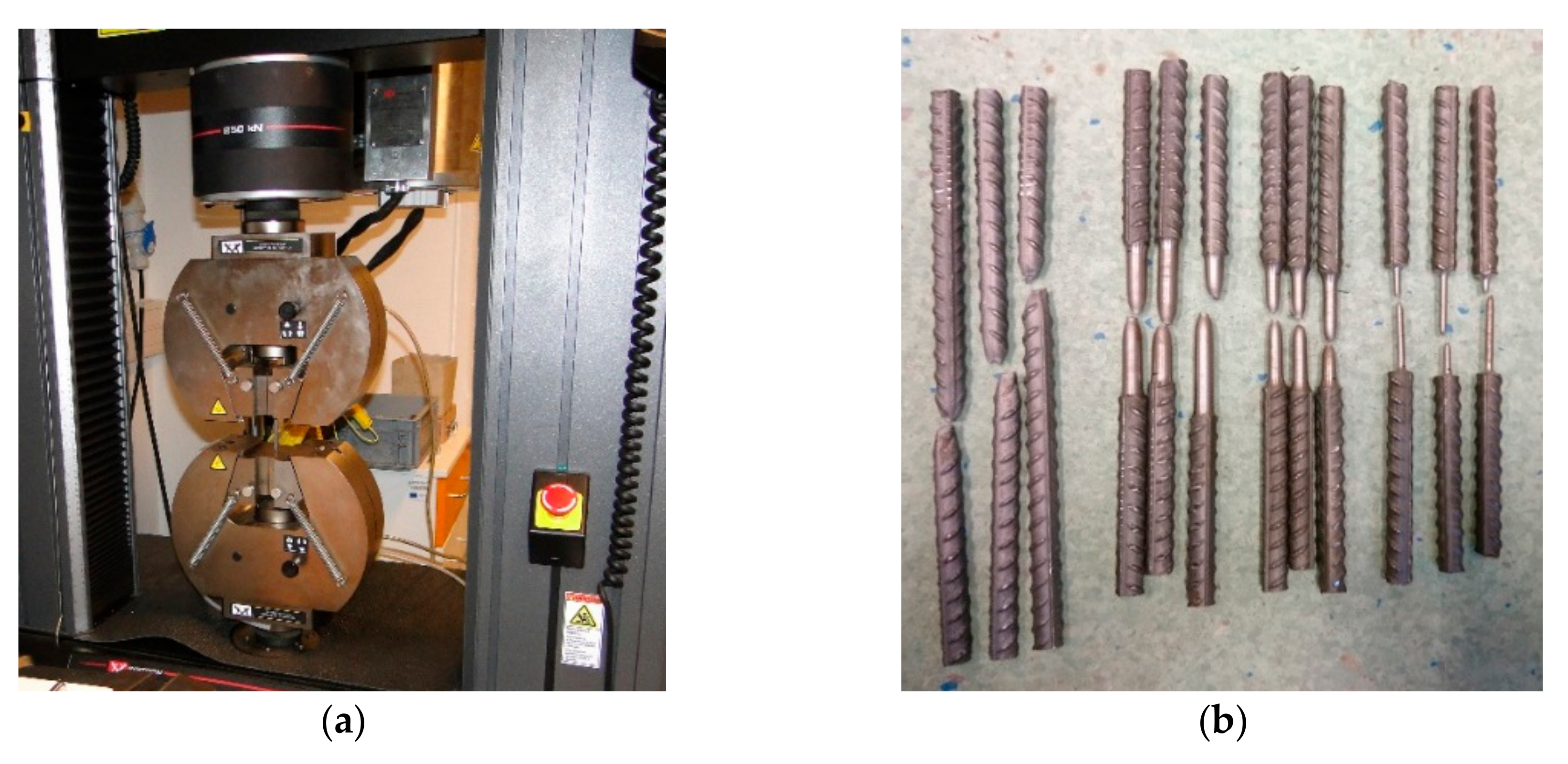
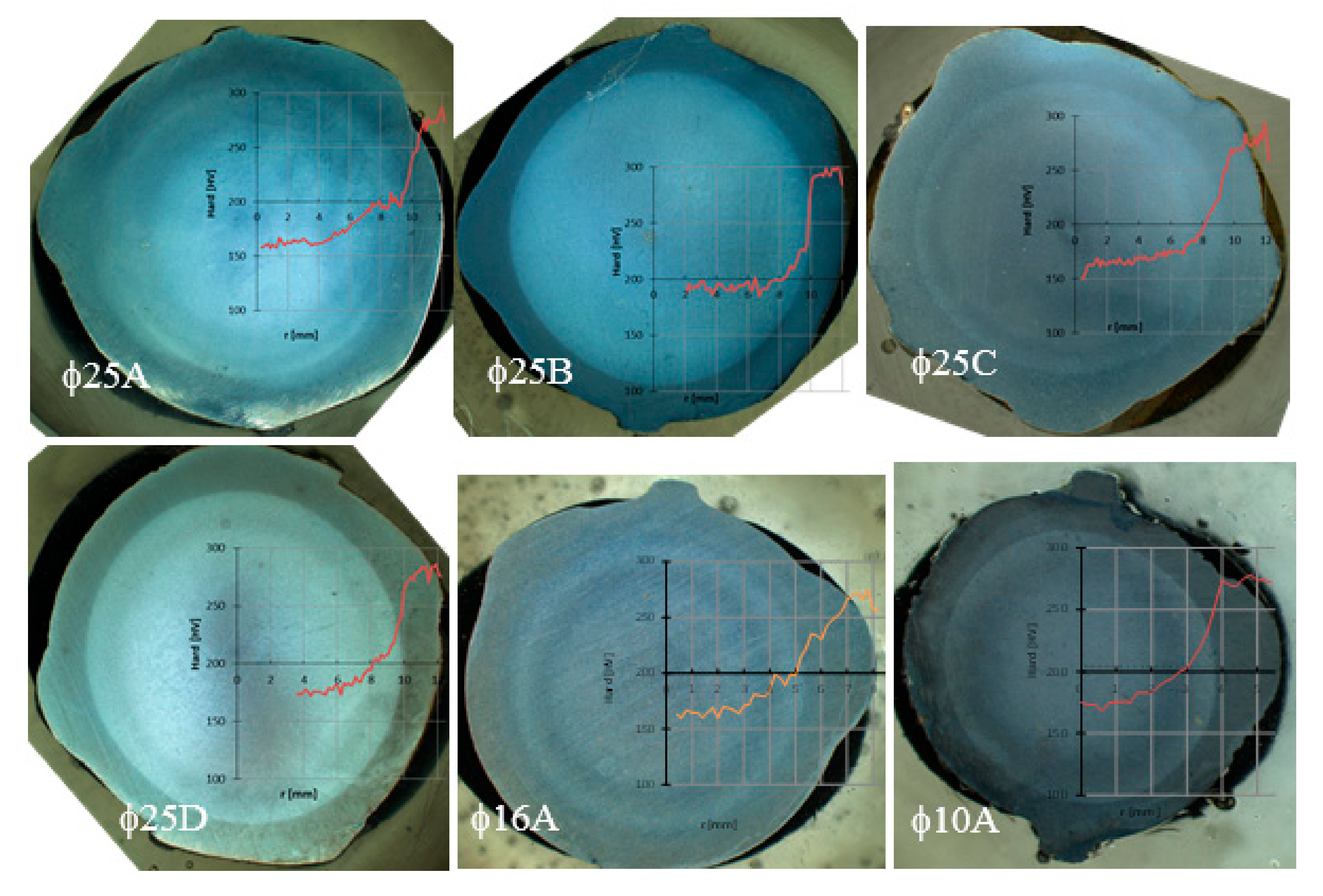
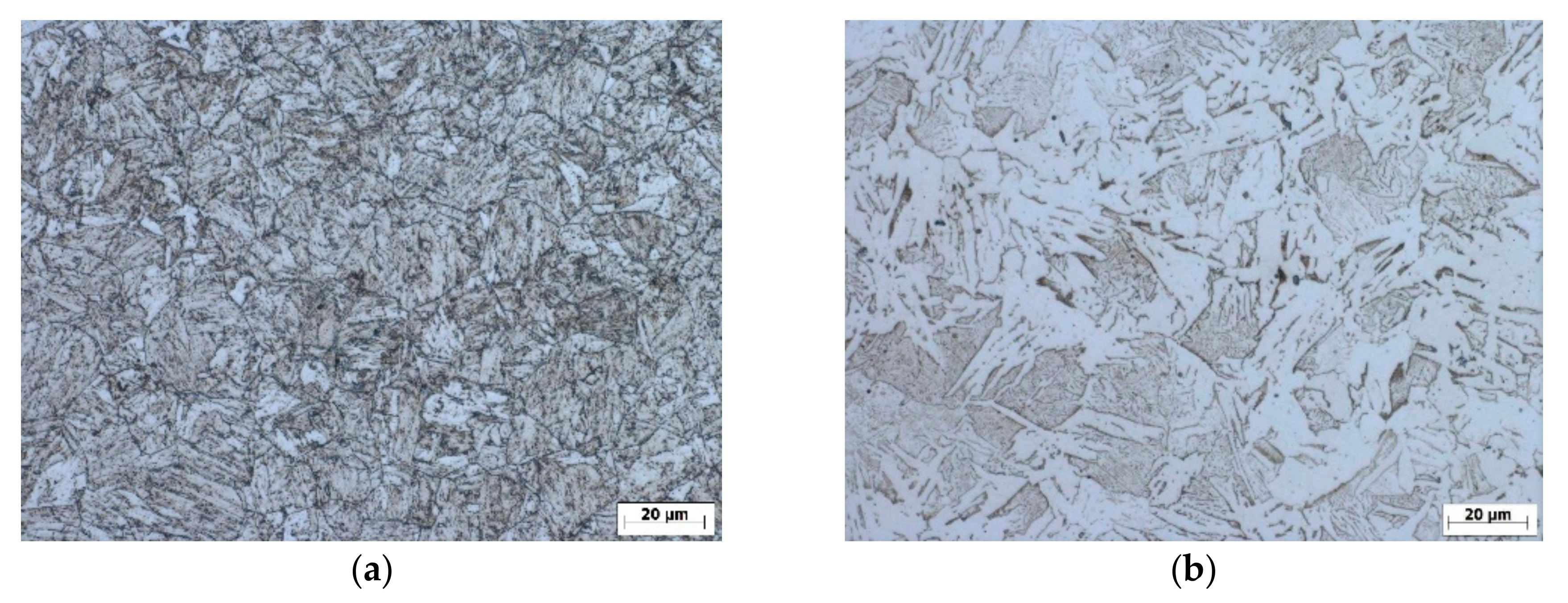
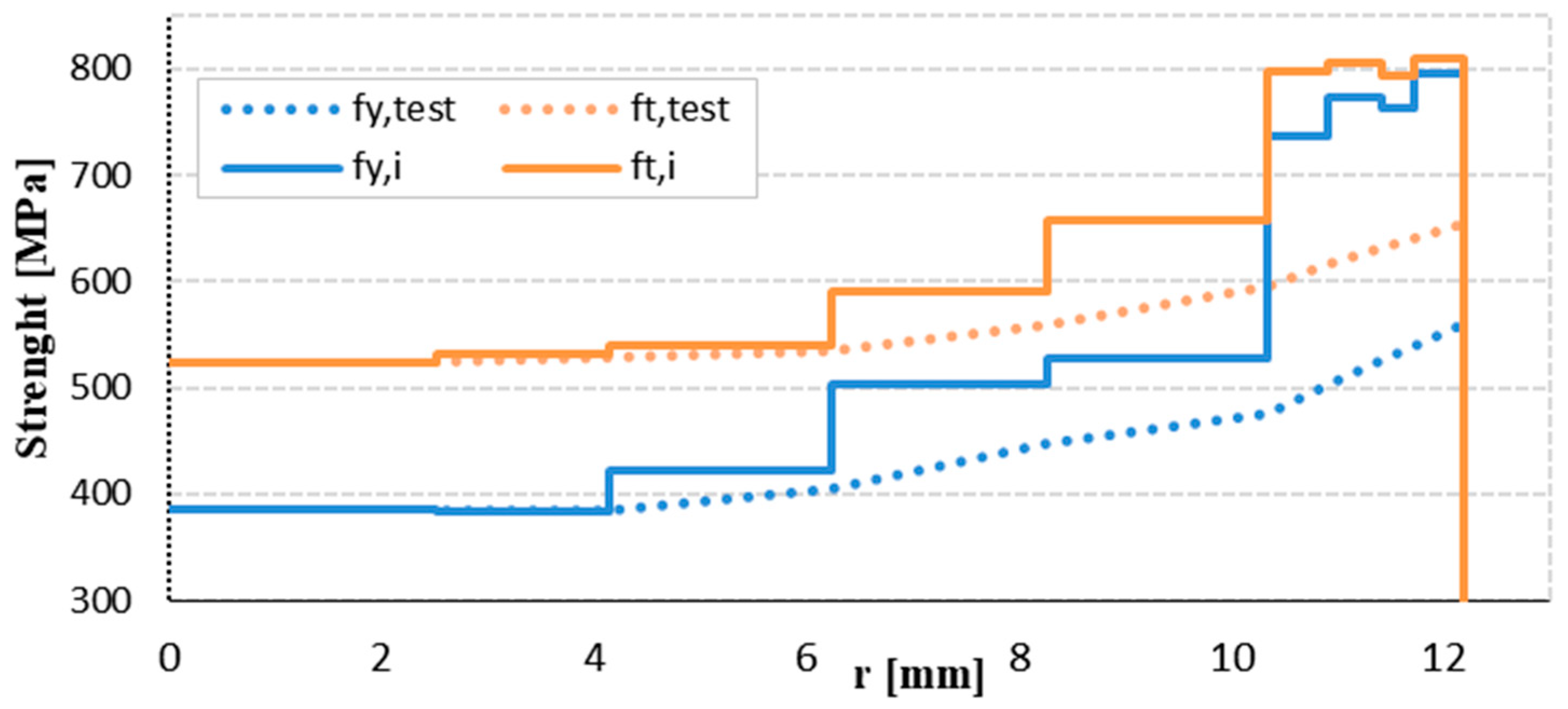
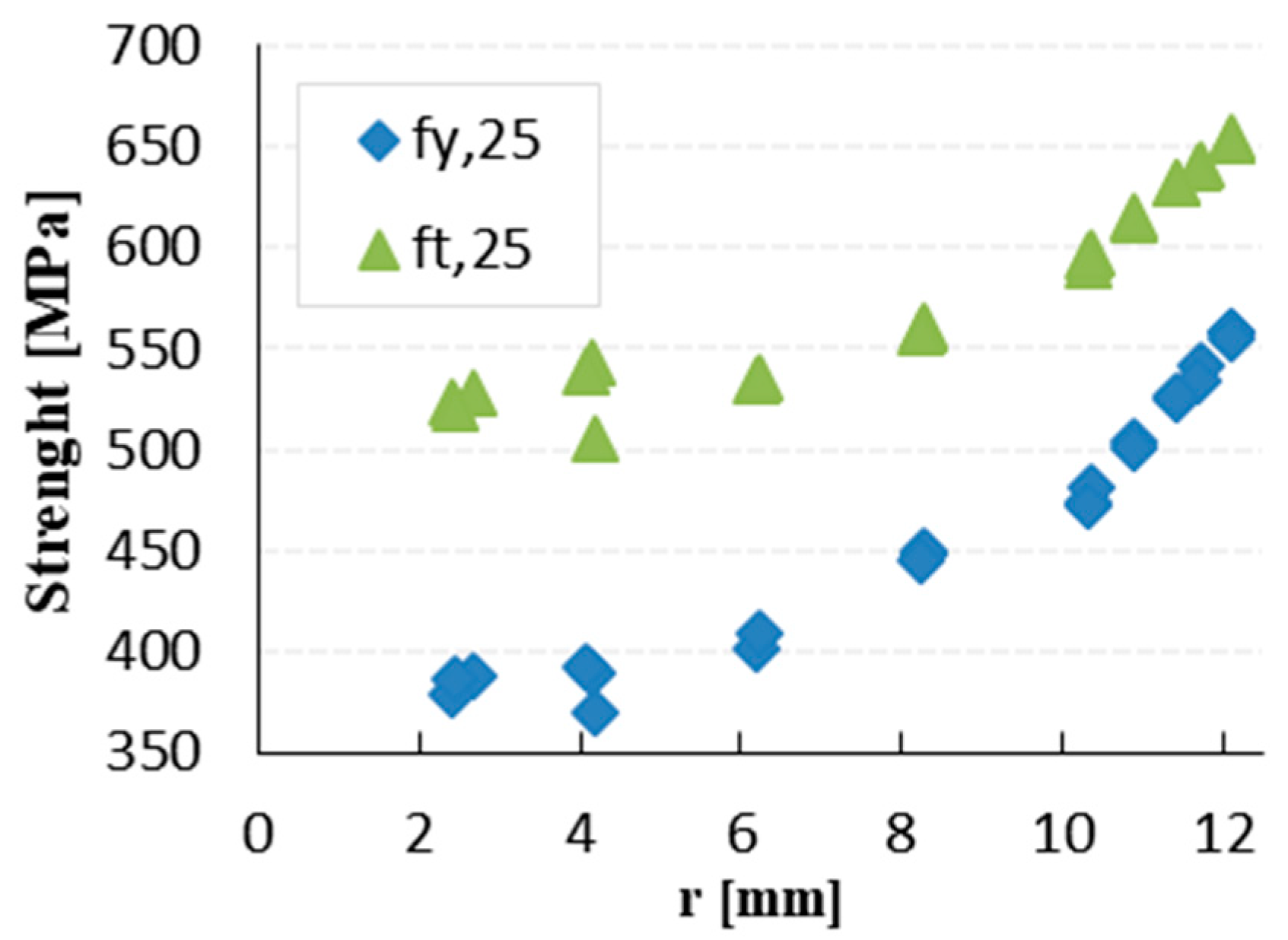
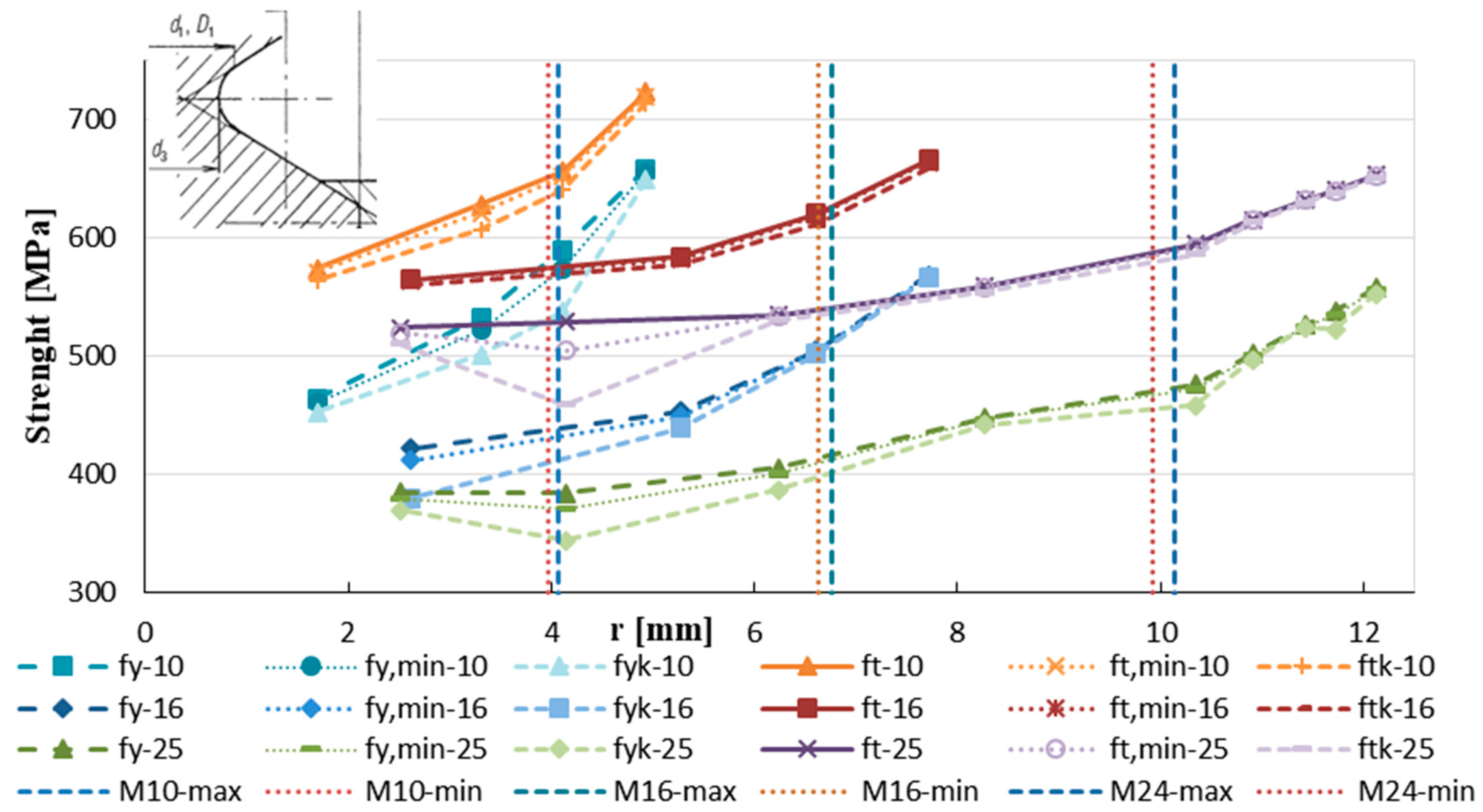
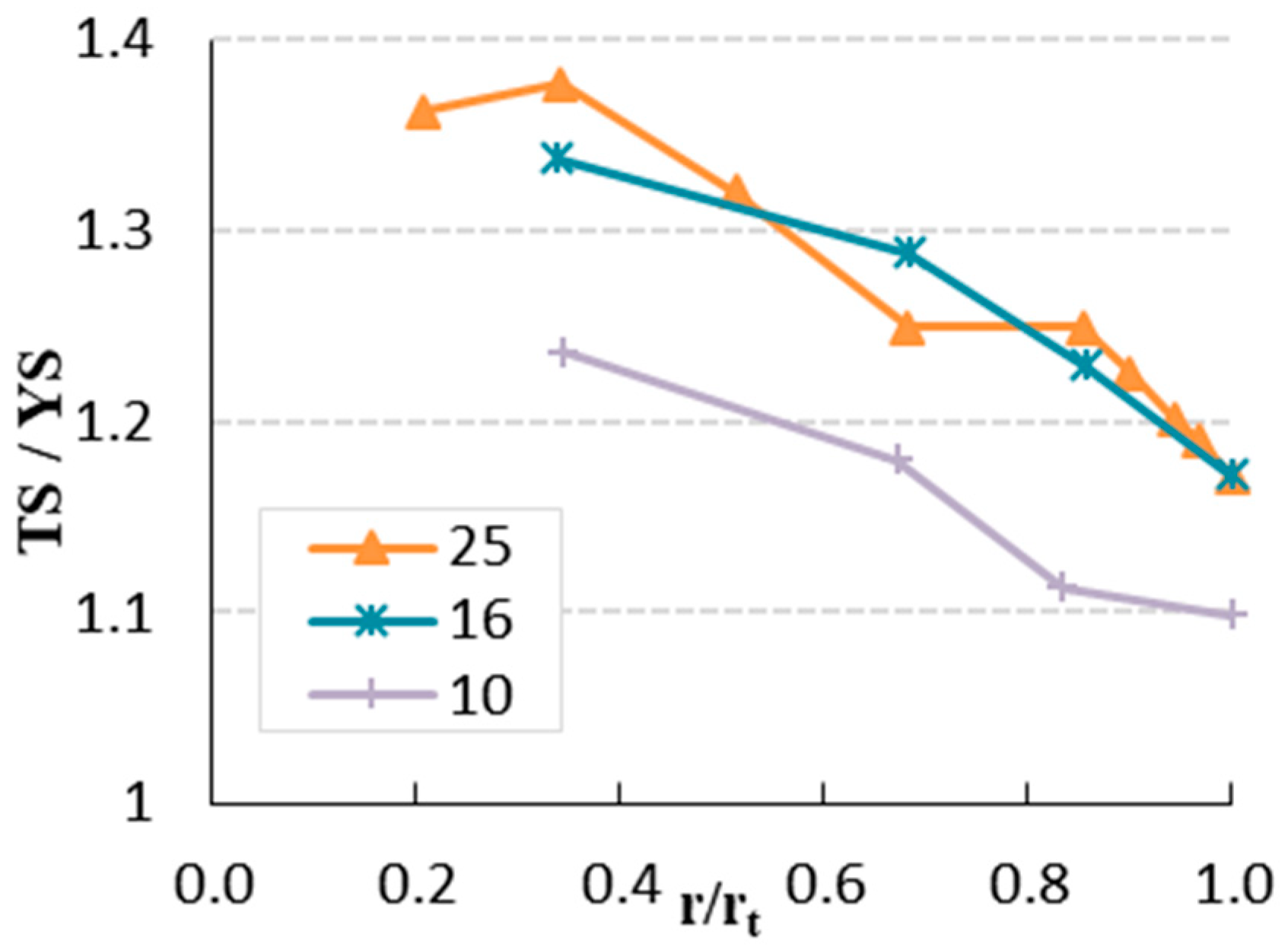

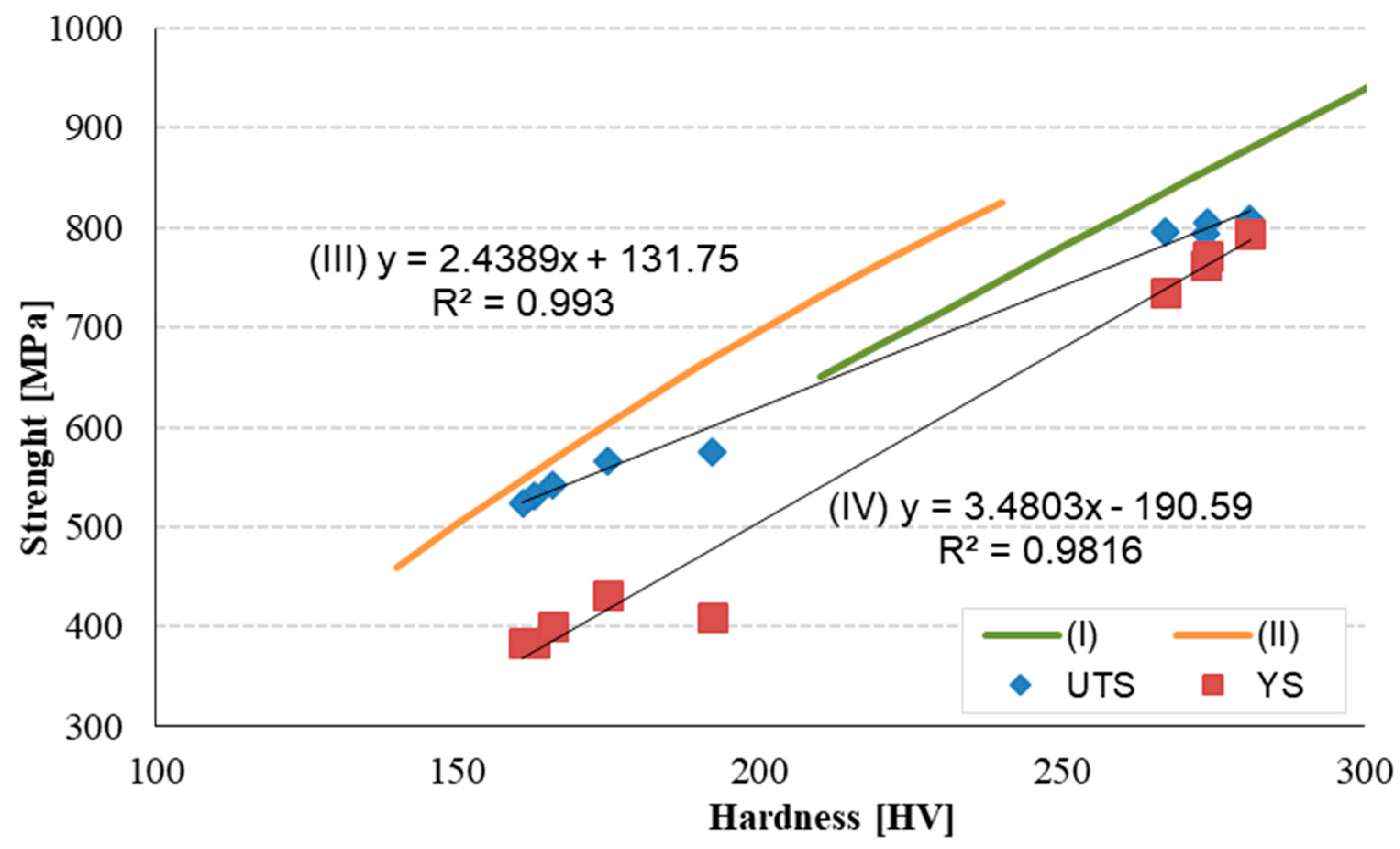
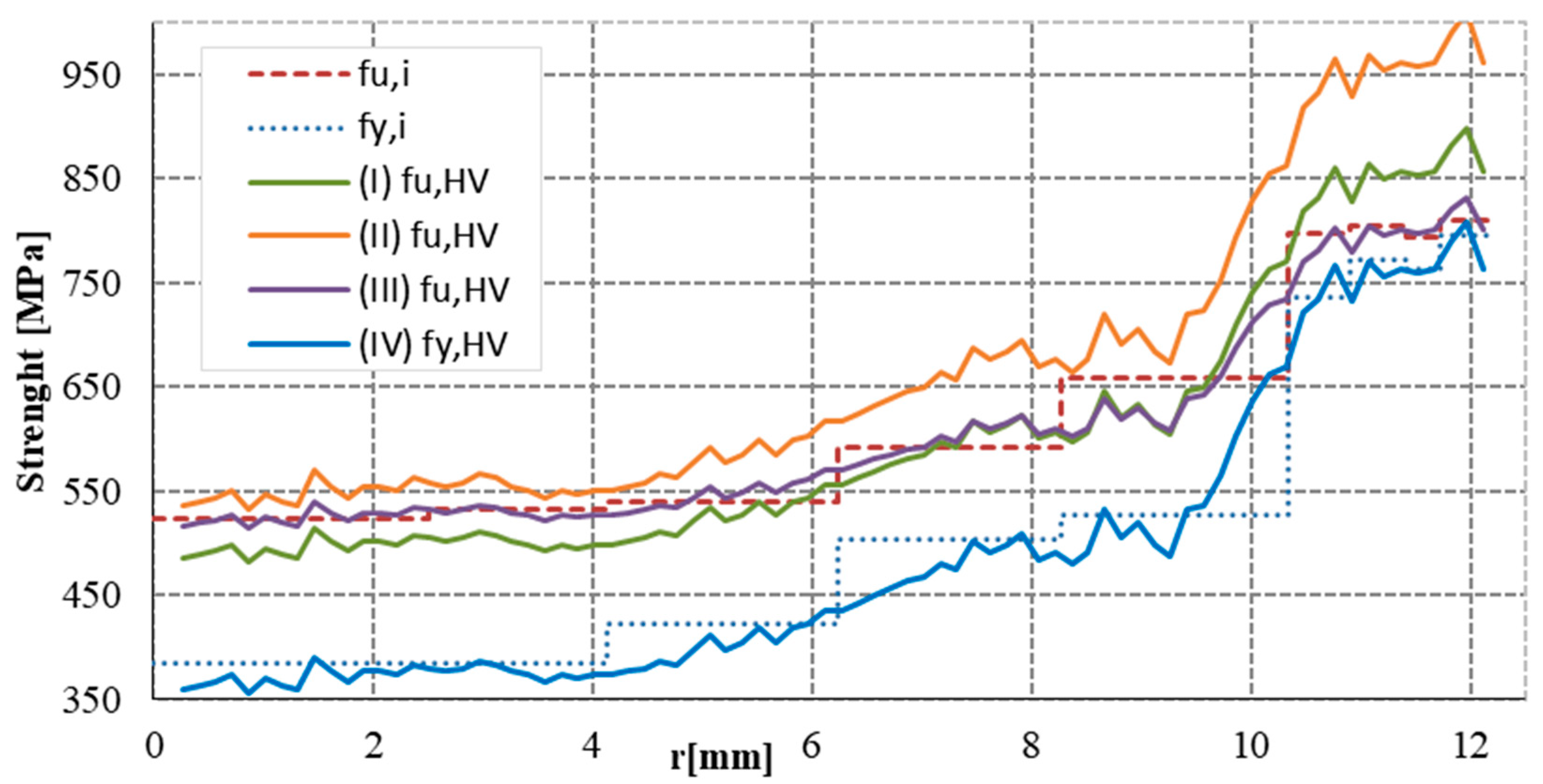
| Material Properties/Type of Reinforcing Steel | B500B | B500C |
|---|---|---|
| Yield strength (fyk) | ≥500 N/mm2 | ≥500 N/mm2 |
| Ratio of tensile strength over yield strength (fu/fyk) | ≥1.08 | ≥1.15 ≤ 1.35 |
| Characteristic elongation at maximum force | ≥5% | ≥7.5% |
| type | d | As | fy | ft | fy,min | fyk | ft,min | ftk | fy/fy,t | ft/ft,t | fyk/fyk,t | fyk/500 | ft/fy |
|---|---|---|---|---|---|---|---|---|---|---|---|---|---|
| (mm) | (mm2) | (MPa) | (MPa) | (MPa) | (MPa) | (MPa) | (MPa) | (-) | (-) | (-) | (-) | (-) | |
| φ25A | 25 * | 490.9 | 524 | 614 | 522 | 519 | 613 | 611 | 0.940 | 0.940 | 0.940 | 1.039 | 1.171 |
| 24.24 x | 461.4 | 558 | 653 | 556 | 553 | 653 | 650 | 1.000 | 1.000 | 1.000 | 1.105 | 1.171 | |
| 23.44 | 431.5 | 538 | 640 | 535 | 522 | 640 | 639 | 0.965 | 0.981 | 0.945 | 1.044 | 1.191 | |
| 22.85 | 409.9 | 526 | 632 | 526 | 524 | 632 | 630 | 0.944 | 0.968 | 0.948 | 1.048 | 1.201 | |
| 21.81 | 373.6 | 502 | 615 | 501 | 497 | 615 | 613 | 0.901 | 0.942 | 0.899 | 0.993 | 1.225 | |
| 20.69 | 336.1 | 476 | 595 | 472 | 458 | 592 | 586 | 0.854 | 0.911 | 0.830 | 0.917 | 1.250 | |
| 16.53 | 214.7 | 448 | 559 | 446 | 442 | 558 | 554 | 0.803 | 0.856 | 0.799 | 0.884 | 1.250 | |
| 12.46 | 121.9 | 405 | 535 | 401 | 387 | 534 | 530 | 0.727 | 0.819 | 0.700 | 0.774 | 1.320 | |
| 8.27 | 53.8 | 384 | 529 | 370 | 343 | 505 | 459 | 0.689 | 0.810 | 0.622 | 0.687 | 1.377 | |
| 5.02 | 19.8 | 385 | 524 | 380 | 369 | 520 | 511 | 0.690 | 0.802 | 0.668 | 0.739 | 1.363 | |
| φ16A | 16 * | 201.1 | 528 | 619 | 527 | 526 | 617 | 613 | 0.929 | 0.929 | 0.929 | 1.052 | 1.172 |
| 15.42 x | 186.8 | 568 | 666 | 568 | 566 | 664 | 659 | 1.000 | 1.000 | 1.000 | 1.132 | 1.172 | |
| 13.22 | 137.2 | 505 | 621 | 504 | 502 | 619 | 611 | 0.888 | 0.932 | 0.887 | 1.004 | 1.230 | |
| 10.53 | 87.1 | 453 | 584 | 449 | 439 | 582 | 577 | 0.797 | 0.877 | 0.775 | 0.878 | 1.289 | |
| 5.23 | 21.5 | 422 | 565 | 412 | 379 | 564 | 561 | 0.743 | 0.848 | 0.671 | 0.759 | 1.338 | |
| φ10A | 10 * | 78.5 | 639 | 702 | 636 | 630 | 699 | 693 | 0.971 | 0.971 | 0.971 | 1.260 | 1.098 |
| 9.85 x | 76.3 | 659 | 723 | 655 | 649 | 720 | 714 | 1.000 | 1.000 | 1.000 | 1.298 | 1.098 | |
| 8.22 | 53.0 | 590 | 656 | 573 | 537 | 652 | 641 | 0.895 | 0.907 | 0.829 | 1.075 | 1.113 | |
| 6.62 | 34.4 | 533 | 628 | 522 | 501 | 621 | 607 | 0.809 | 0.868 | 0.772 | 1.002 | 1.180 | |
| 3.39 | 9.0 | 464 | 574 | 461 | 453 | 571 | 564 | 0.705 | 0.793 | 0.697 | 0.905 | 1.237 |
| Producer | d | dc | fy,c | fy,c,min | fyk,c | ft,c | fy | fy,min | fyk | ft | fy,c/fy | ft,c/ ft | fy/ft,c | ft,c/fy,c |
|---|---|---|---|---|---|---|---|---|---|---|---|---|---|---|
| (mm) | (mm) | (MPa) | (MPa) | (MPa) | (MPa) | (MPa) | (MPa) | (MPa) | (MPa) | (-) | (-) | (-) | (-) | |
| A | 25 | 8.27 | 384 | 370 | 344 | 529 | 524 | 522 | 519 | 614 | 0.733 | 0.862 | 0.991 | 1.377 |
| B | 25 | 8.24 | 410 | 406 | 396 | 576 | 542 | 541 | 541 | 655 | 0.757 | 0.879 | 0.941 | 1.404 |
| C | 25 | 8.20 | 401 | 399 | 394 | 543 | 542 | 541 | 540 | 640 | 0.741 | 0.848 | 0.998 | 1.354 |
| D | 25 | 8.25 | 432 | 414 | 376 | 566 | 542 | 541 | 540 | 644 | 0.798 | 0.880 | 0.957 | 1.310 |
| A | 16 | 5.23 | 422 | 412 | 380 | 565 | 528 | 527 | 526 | 619 | 0.799 | 0.912 | 0.935 | 1.338 |
| A | 10 | 3.39 | 464 | 461 | 501 | 574 | 639 | 636 | 630 | 702 | 0.726 | 0.817 | 1.114 | 1.237 |
| Type | d | YS/fy,test | TS/fu,test | n degree | fu(I) | fu(II) | fu(III) | fy(IV) | p(I) | p(II) | p(III) | p(IV) |
|---|---|---|---|---|---|---|---|---|---|---|---|---|
| (mm) | (MPa) | (MPa) | (MPa) | (MPa) | (MPa) | (MPa) | % | % | % | % | ||
| φ25A | 24.24 | 558 | 653 | 6 | 639 | 740 | 652 | 591 | −2.2 | 13.4 | −0.2 | 6.0 |
| 1 | 671 | 757 | 658 | 561 | 2.7 | 15.9 | 0.8 | 0.6 | ||||
| 23.44 | 538 | 640 | 6 | 630 | 726 | 641 | 569 | −1.7 | 13.3 | 0.1 | 5.7 | |
| 22.85 | 526 | 632 | 6 | 621 | 714 | 632 | 552 | −1.8 | 12.9 | 0.1 | 4.9 | |
| 21.81 | 502 | 615 | 6 | 605 | 692 | 617 | 523 | −1.7 | 12.5 | 0.3 | 4.2 | |
| 20.69 | 476 | 595 | 6 | 588 | 670 | 602 | 495 | −1.2 | 12.6 | 1.1 | 4.1 | |
| 16.53 | 448 | 559 | 6 | 547 | 619 | 566 | 433 | −2.1 | 10.6 | 1.2 | −3.3 | |
| 12.46 | 405 | 535 | 6 | 526 | 592 | 548 | 404 | −1.7 | 10.7 | 2.4 | −0.3 | |
| 8.27 | 384 | 529 | 6 | 506 | 570 | 533 | 382 | −4.3 | 7.7 | 0.7 | −0.7 | |
| 5.02 | 385 | 524 | 6 | 504 | 568 | 531 | 380 | −3.7 | 8.4 | 1.4 | −1.3 | |
| φ25B | 24 | 588 | 711 | 6 | 731 | 799 | 715 | 652 | 2.9 | 12.4 | 0.5 | 10.9 |
| 1 | 716 | 801 | 693 | 610 | 0.7 | 12.6 | −2.5 | 3.7 | ||||
| 8.24 | 410 | 576 | 6 | 596 | 663 | 602 | 480 | 3.6 | 15.3 | 4.5 | 17.0 | |
| φ25C | 24.22 | 577 | 682 | 5 | 690 | 768 | 673 | 582 | 1.1 | 12.6 | −1.3 | 0.9 |
| 1 | 688 | 769 | 672 | 580 | 0.9 | 12.7 | −1.5 | 0.4 | ||||
| 8.2 | 401 | 543 | 5 | 513 | 567 | 538 | 389 | −5.6 | 4.5 | −1.0 | −3.1 | |
| φ25D | 24.12 | 582 | 691 | 6 | 694 | 774 | 677 | 557 | 0.4 | 11.9 | −2.1 | −4.2 |
| 1 | 674 | 753 | 661 | 564 | −2.4 | 8.9 | −4.3 | −3.0 | ||||
| 8.24 | 432 | 566 | 6 | 539 | 597 | 557 | 417 | −4.9 | 5.5 | −1.5 | −3.6 | |
| φ16A | 15.42 | 568 | 666 | 5 | 681 | 760 | 666 | 572 | 2.3 | 14.1 | 0.0 | 0.6 |
| 1 | 682 | 762 | 667 | 573 | 2.4 | 14.3 | 0.2 | 0.8 | ||||
| φ10A | 9.85 | 659 | 723 | 5 | 716 | 801 | 697 | 607 | −1.0 | 10.7 | −3.6 | −7.9 |
| 1 | 716 | 800 | 697 | 605 | −1.1 | 10.6 | −3.7 | −8.1 |
| Rebar | Thread | d,max | d,min | fy,dmax | fy,dmin | fyk > 500 MPa |
|---|---|---|---|---|---|---|
| (mm) | (mm) | (MPa) | (MPa) | |||
| φ10 | M10 | 8.128 | 7.938 | 533.1 | 524.9 | ok |
| φ16 | M16 | 13.508 | 13.271 | 521.1 | 514.7 | ok |
| A φ25 | M24 | 20.271 | 19.840 | 486.4 | 477.7 | x |
| B φ25 | M24 | 20.271 | 19.840 | 540.5 | 530.0 | ok |
| C φ25 | M24 | 20.271 | 19.840 | 494.4 | 484.5 | x |
| D φ25 | M24 | 20.271 | 19.840 | 483.7 | 475.9 | x |
© 2019 by the authors. Licensee MDPI, Basel, Switzerland. This article is an open access article distributed under the terms and conditions of the Creative Commons Attribution (CC BY) license (http://creativecommons.org/licenses/by/4.0/).
Share and Cite
Bahleda, F.; Bujňáková, P.; Koteš, P.; Hasajová, L.; Nový, F. Mechanical Properties of Cast-in Anchor Bolts Manufactured of Reinforcing Tempcore Steel. Materials 2019, 12, 2075. https://doi.org/10.3390/ma12132075
Bahleda F, Bujňáková P, Koteš P, Hasajová L, Nový F. Mechanical Properties of Cast-in Anchor Bolts Manufactured of Reinforcing Tempcore Steel. Materials. 2019; 12(13):2075. https://doi.org/10.3390/ma12132075
Chicago/Turabian StyleBahleda, František, Petra Bujňáková, Peter Koteš, Lívia Hasajová, and František Nový. 2019. "Mechanical Properties of Cast-in Anchor Bolts Manufactured of Reinforcing Tempcore Steel" Materials 12, no. 13: 2075. https://doi.org/10.3390/ma12132075





